Low-impact workouts can greatly calm your anxious mind by regulating your body's stress response. Unlike high-intensity exercises that may trigger panic-like symptoms, gentle movements help maintain balanced cortisol and adrenaline levels while releasing mood-boosting endorphins. You'll experience the benefits of exercise without overwhelming your nervous system, as activities like swimming, walking meditation, and resistance band training provide controlled, mindful movement patterns. These workouts create a "rest and digest" state that naturally eases tension and promotes mental clarity. By starting with gentle exercises, you'll discover a sustainable path to both physical and emotional well-being.
The Science Behind Exercise Anxiety
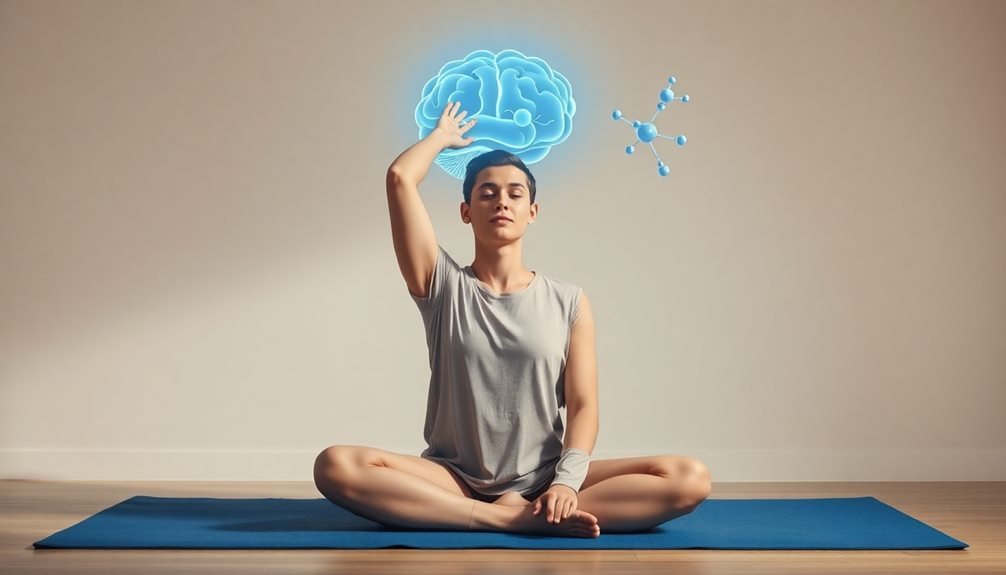
While many people experience anxiety during exercise, the physiological response behind this reaction is remarkably similar to anxiety itself. When you work out intensely, your heart rate increases, you breathe harder, and you might start sweating – symptoms that mirror a panic attack. For those with anxiety disorders, these physical sensations can trigger fear responses and heighten existing stress levels.
Your body releases stress hormones like cortisol and adrenaline during high-intensity exercise, which can overwhelm an already sensitive nervous system. If you're prone to anxiety, these hormones might push you into "fight or flight" mode, making your workout feel threatening rather than beneficial. Research shows that about 40% of people with anxiety disorders report exercise-induced panic symptoms.
That's why low-impact workouts can serve as an ideal solution. These gentler forms of movement don't trigger the same intense physiological responses. They allow you to maintain better control over your breathing and heart rate while still getting the mental health benefits of exercise, including reduced anxiety, improved mood, and better stress management through the release of endorphins and other mood-regulating neurotransmitters.
Stress Hormones During Gentle Movement
Unlike high-intensity exercises that flood your body with stress hormones, gentle movement promotes a more balanced hormonal response. When you engage in low-impact activities, your body naturally regulates cortisol levels while gradually increasing beneficial hormones like endorphins and serotonin.
You'll notice significant differences in how your body responds to gentle versus intense exercise:
| Stress Hormone | Gentle Movement vs. Intense Exercise |
|---|---|
| Cortisol | Stays balanced vs. Spikes dramatically |
| Adrenaline | Minimal release vs. Sudden surge |
| Norepinephrine | Gradual increase vs. Sharp elevation |
| Growth Hormone | Steady release vs. Erratic output |
During gentle movement, your body maintains a state of "rest and digest" rather than "fight or flight." This allows you to reap exercise benefits without triggering anxiety symptoms. As you flow through low-impact movements, your parasympathetic nervous system remains active, helping you process stress more effectively.
When you're dealing with anxiety, these gentler hormone fluctuations can make a significant difference in your overall well-being, allowing your body to adapt and strengthen without overwhelming your nervous system.
Best Equipment For Anxious Exercisers
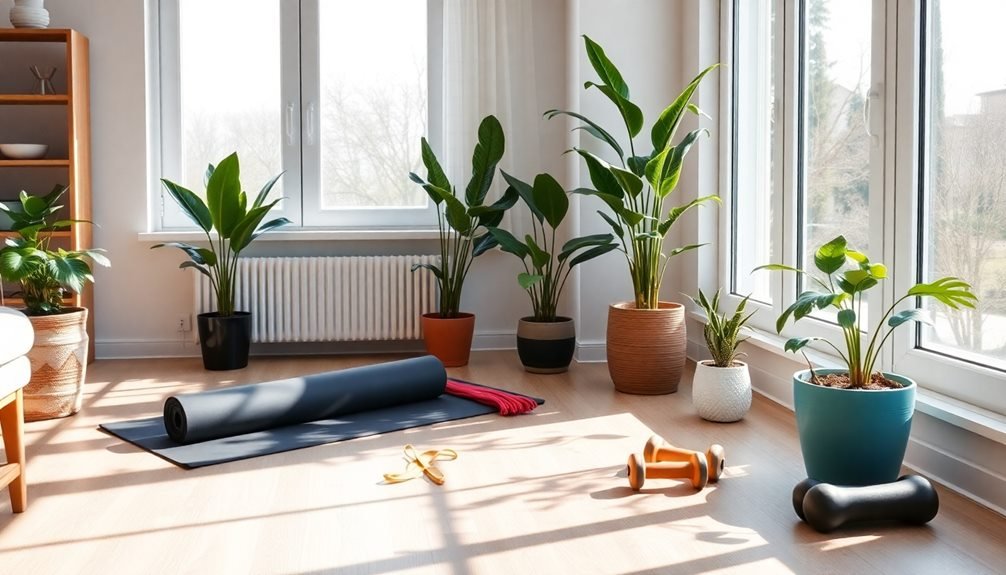
When you're new to exercising with anxiety, starting with the right equipment can make all the difference in building confidence and comfort.
You'll find beginner-friendly resistance bands and foam rollers particularly helpful, as they allow you to work at your own pace while releasing physical tension that often accompanies stress.
Portable stability tools like balance discs or small hand weights can provide a sense of control and groundedness during your workout, making them ideal companions for anxious exercisers.
Beginner-Friendly Resistance Bands
Resistance bands stand out as the perfect exercise companion for anyone battling anxiety. They're lightweight, portable, and won't overwhelm you with complex mechanisms or intimidating designs. Unlike heavy weights that might trigger stress, these colorful bands offer gentle resistance that you can easily control and adjust to your comfort level.
When you're feeling anxious, having equipment that's simple to use can make a significant difference in your workout experience. You'll find that resistance bands provide a smooth, fluid motion that helps maintain steady breathing patterns – an essential element for managing anxiety during exercise. They're also quiet, so you won't draw unwanted attention while working out at home or in public spaces.
- Start with light resistance bands (usually yellow or green) for upper body exercises like shoulder presses and bicep curls.
- Use medium bands (typically red or blue) for lower body movements such as squats and leg presses.
- Keep a long band and a loop band in your collection to maximize exercise variety without overwhelming yourself.
Store your bands in an easily accessible place, making them a convenient go-to option whenever anxiety strikes and you need to move your body.
Foam Rollers For Tension
Foam rollers stand out among the best anxiety-management tools due to their dual benefits of physical and mental relief. When you're feeling overwhelmed, these cylindrical tools can help release muscle tension while promoting mindfulness through focused movements and breathing.
You'll find foam rollers particularly effective for targeting common anxiety-holding spots like your upper back, shoulders, and neck. By applying gentle pressure and rolling slowly over these areas, you're not just breaking up muscle knots – you're also triggering your body's relaxation response through the stimulation of pressure points.
To maximize tension relief, start with your back against the roller while lying on the floor. Roll slowly from your upper to lower back, pausing on particularly tense areas for 20-30 seconds. When you hit a tender spot, take deep breaths and remind yourself that you're actively releasing both physical and mental stress.
You can also use the roller for your legs, hips, and IT bands, areas where anxiety-induced tension often accumulates.
Choose a medium-density roller if you're new to this practice – it'll provide enough pressure without being overwhelming.
Portable Stability Tools
Moving beyond stationary tools like foam rollers, portable stability equipment offers anxiety-friendly workout options you can take anywhere.
These lightweight tools help you maintain control over your exercise environment while providing gentle resistance and balance challenges that keep your mind focused on movement rather than worry.
Compact stability tools like resistance bands, small balance discs, and yoga blocks don't just support your physical practice – they're essential allies in managing anxiety through movement.
You'll find these tools especially helpful when traveling or when you're not comfortable exercising in public spaces.
- Resistance bands give you precise control over tension levels, letting you adjust the intensity of your movements based on your anxiety levels that day. They're perfect for gentle strength training and stretching exercises.
- Balance discs create a slightly unstable surface that requires focus and mindfulness, effectively redirecting anxious thoughts toward maintaining proper form and stability.
- Travel-sized yoga blocks provide support during floor work and standing poses, offering a sense of security when you need to modify movements or maintain steady breathing through challenging positions.
Choose tools that feel comfortable in your hands and pack easily into your bag, making anxiety-managed exercise possible wherever you go.
Swimming As Mental Medicine
You'll find that swimming's rhythmic motions naturally release tension from your anxious mind as you glide through the water.
The gentle pressure and buoyancy of water create a unique therapeutic environment that reduces stress hormones and promotes mental clarity.
When you're submerged, the mind-body connection strengthens as you focus on your breathing and movements, leaving little room for anxious thoughts.
Rhythmic Movement Calms Nerves
Inside the rhythmic flow of swimming, your mind finds a natural sanctuary from anxious thoughts. The repetitive nature of each stroke creates a meditative state, where your brain's stress response begins to quiet down.
You'll notice your breathing naturally synchronizes with your movements, creating a calming effect that extends beyond the pool.
When you're swimming, your body releases endorphins while following predictable patterns that help reduce anxiety. The water's gentle resistance provides constant feedback, keeping you anchored in the present moment rather than dwelling on worries.
To maximize swimming's anxiety-reducing benefits:
- Focus on your breath timing – count "1-2-3" with each stroke to establish a steady rhythm
- Pay attention to the water's sensation against your skin, using it as a mindfulness anchor
- Start with short sessions of 15-20 minutes and gradually increase duration as you become more comfortable
This rhythmic movement doesn't just exercise your body – it creates a moving meditation that can break anxiety's hold on your thoughts.
You'll often find that your mind feels clearer and calmer after each session, making swimming an effective tool for managing daily stress.
Water's Natural Stress Relief
The healing power of water extends far beyond physical exercise. When you're immersed in water, your body experiences a natural weightlessness that instantly reduces physical tension and mental stress.
The gentle pressure of water against your skin creates a calming, womb-like environment that helps quiet an overactive mind.
Swimming laps provides a meditative rhythm that can break anxiety's grip on your thoughts. As you focus on your breathing and stroke pattern, you'll find your mind clearing of worried thoughts. The repetitive nature of swimming movements, combined with the water's natural resistance, creates a flow state that's similar to meditation.
You don't need to be an expert swimmer to benefit from water therapy. Simple water walking, treading, or floating can greatly lower your stress levels.
The pool's temperature also plays a role – warm water relaxes your muscles, while cool water invigorates your senses and releases endorphins.
Plus, the sound of moving water itself triggers your brain's relaxation response, similar to how waves or rainfall can lull you into a peaceful state.
Mind-Body Connection Underwater
During your time in the water, swimming engages both mind and body in a uniquely synchronized dance. As you glide through the pool, your brain enters a meditative state while your muscles work in harmony. The repetitive nature of swimming strokes creates a natural rhythm that helps quiet anxious thoughts and promotes mental clarity.
The underwater environment forces you to focus on your breathing patterns, creating a natural form of breath control similar to meditation practices. You'll find that the water's resistance provides gentle feedback for every movement, making you more aware of your body's position and helping you stay present in the moment.
Here's how swimming specifically targets anxiety reduction:
- The pressure of water against your skin activates your parasympathetic nervous system, naturally lowering stress hormones.
- The rhythmic breathing required for swimming helps regulate your heart rate and blood pressure.
- The weightless environment reduces physical tension, allowing your muscles and mind to release accumulated stress.
When you're underwater, you're temporarily separated from external stressors, creating a protective bubble where you can process thoughts and emotions while maintaining physical activity.
Walking Meditation Benefits

Walking meditation combines physical activity with mindfulness to create a powerful anxiety-reducing practice. As you walk, you'll focus on each step, the rhythm of your breath, and the sensations in your body, which naturally draws your attention away from racing thoughts and worries. This simple yet effective technique helps you stay present in the moment rather than dwelling on past concerns or future uncertainties.
You don't need special equipment or training to begin. Start by choosing a quiet path or area where you can walk uninterrupted for 15-30 minutes. Pay attention to how your feet connect with the ground, the way your arms swing naturally, and the movement of air across your skin.
When your mind wanders, gently bring your focus back to your physical sensations and breathing.
Research shows that walking meditation can lower cortisol levels, reduce blood pressure, and improve sleep quality. You'll likely notice immediate benefits like decreased muscle tension and mental clarity, while regular practice can lead to lasting improvements in your ability to manage anxiety and stress throughout the day.
Creating Your Comfort Zone
Finding your ideal exercise environment plays an essential role in managing anxiety during workouts. You'll need to identify spaces where you feel safe, comfortable, and in control of your surroundings.
Whether you prefer exercising at home, in a quiet park, or during off-peak hours at the gym, establishing your comfort zone helps reduce workout-related stress and builds long-term confidence.
Start by evaluating different exercise settings and notice how each affects your anxiety levels. If you're new to working out or feel particularly anxious in fitness environments, consider these steps to create your personal comfort zone:
- Choose a consistent workout space that feels private and allows you to focus without feeling watched or judged – this might mean setting up a dedicated corner in your home or finding a secluded spot outdoors.
- Control environmental factors like lighting, temperature, and noise levels by using headphones, adjusting window blinds, or selecting specific times of day to exercise.
- Gradually expand your comfort zone by slowly introducing new locations or workout variations only when you feel ready and confident in your current routine.
Mindful Movement Techniques
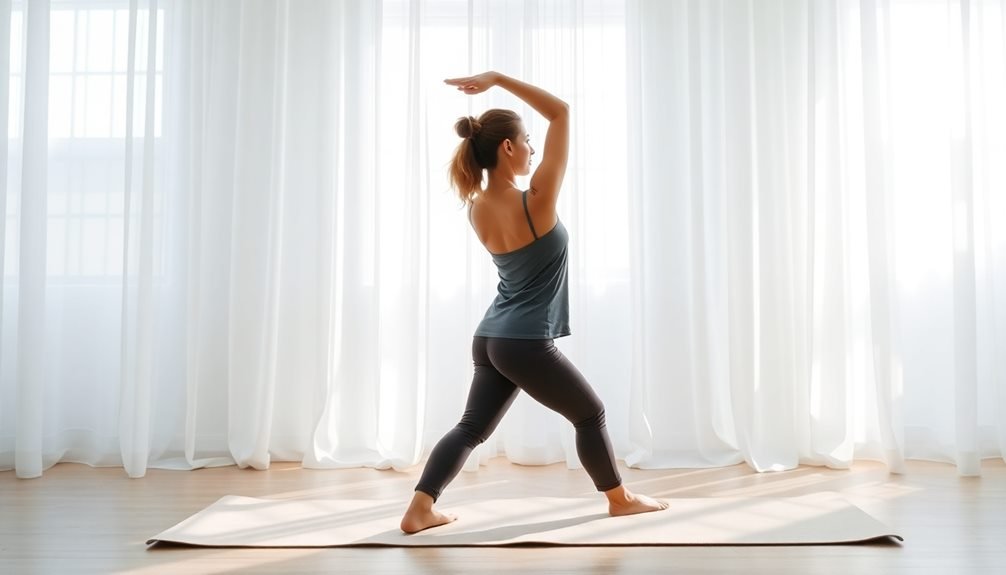
Moving through your workout with mindful awareness can transform exercise from a source of stress into a calming, meditative experience. By focusing on each movement's sensation, you'll naturally quiet anxious thoughts and strengthen the mind-body connection.
Start by practicing breath synchronization – match your movements to your inhales and exhales. During stretches, breathe deeply into areas of tension while mentally scanning your body for areas that need attention.
When walking or doing gentle cardio, focus on how your feet connect with the ground and the rhythm of your steps. You'll find deeper mindfulness through slow, controlled movements like tai chi or gentle yoga flows.
Pay attention to your form, posture, and the way your muscles engage during each exercise. If your mind wanders, gently redirect your focus to physical sensations or your breath without judgment.
Remember to check in with yourself throughout your workout. Notice how different movements affect your energy and mood. This heightened awareness helps you respond to your body's needs while building a more positive relationship with exercise.
Building Sustainable Exercise Habits
Practicing mindful movement sets a strong foundation for lasting fitness habits. When you're dealing with anxiety, you'll find it easier to maintain an exercise routine that feels manageable and aligned with your emotional state.
Start by choosing activities that don't overwhelm you, and gradually build your confidence through consistent practice.
To create sustainable exercise habits that support your mental well-being, consider these key strategies:
- Begin with 10-minute sessions three times a week, then gradually increase duration as your comfort level grows.
- Schedule workouts during your naturally energetic times of day – whether that's early morning or late afternoon.
- Track your mood before and after exercise to reinforce the mental health benefits you're experiencing.
Don't let perfectionism derail your progress. If you miss a day, simply return to your routine the next day without guilt.
You'll find that linking your workouts to daily activities, like a morning shower or evening commute, helps cement these habits into your lifestyle.
Remember that sustainable habits develop through small, consistent actions rather than dramatic changes.
Frequently Asked Questions
How Long Does It Take to Notice Anxiety Reduction From Low-Impact Workouts?
You'll often notice reduced anxiety within 20-30 minutes of starting a low-impact workout. Regular practice can lead to longer-lasting benefits, with many people reporting improved mood and decreased stress after 2-3 weeks.
Can Low-Impact Exercises Be Effective if Done Only on Weekends?
You'll get some benefits from weekend-only workouts, but you won't see ideal anxiety relief. It's better to spread your low-impact exercises throughout the week, even if it's just 15-20 minutes daily.
Should Anxiety Medications Be Taken Before or After Gentle Exercise?
You should always take anxiety medications as prescribed by your doctor, regardless of exercise timing. Don't adjust your medication schedule for workouts – stick to your prescribed times for maximum effectiveness and safety.
Is Exercising With a Partner More Beneficial for Reducing Anxiety?
You'll likely find exercising with a partner more effective for anxiety reduction, as you'll benefit from social support, accountability, and distraction. It's also safer and more motivating than working out alone.
What Time of Day Is Most Effective for Anxiety-Reducing Workouts?
You'll get the best anxiety-reducing benefits by exercising in the morning. It'll kick-start your body's natural cortisol rhythm, boost your mood early, and help you maintain balanced stress levels throughout your day.
In Summary
You'll find that low-impact workouts aren't just easy on your joints – they're gentle on your anxious mind too. By starting slowly and choosing activities that feel comfortable, you're giving yourself permission to move without pressure. Whether it's swimming, walking, or mindful stretching, you're building habits that calm your nervous system and create lasting peace. Remember, consistency matters more than intensity when exercising for mental health.
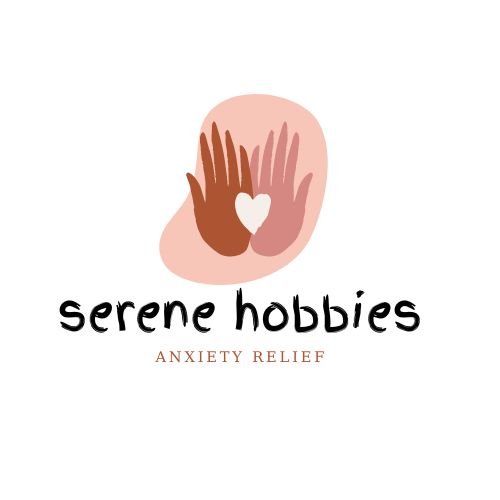
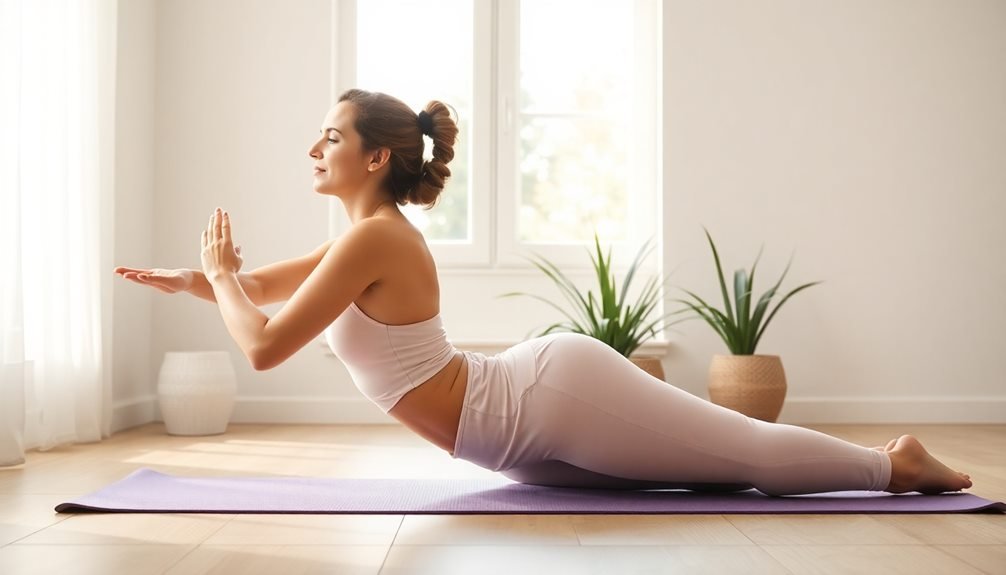
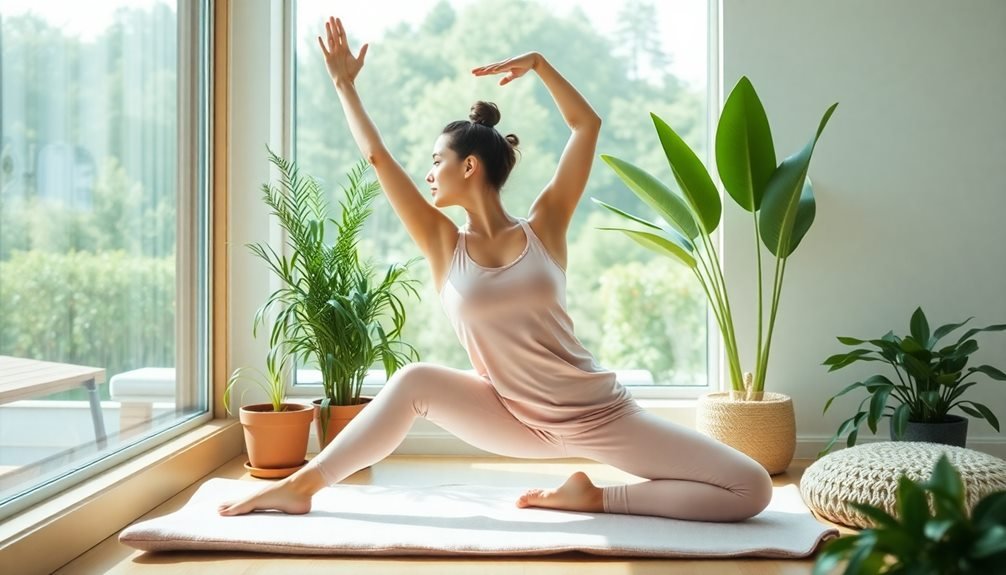
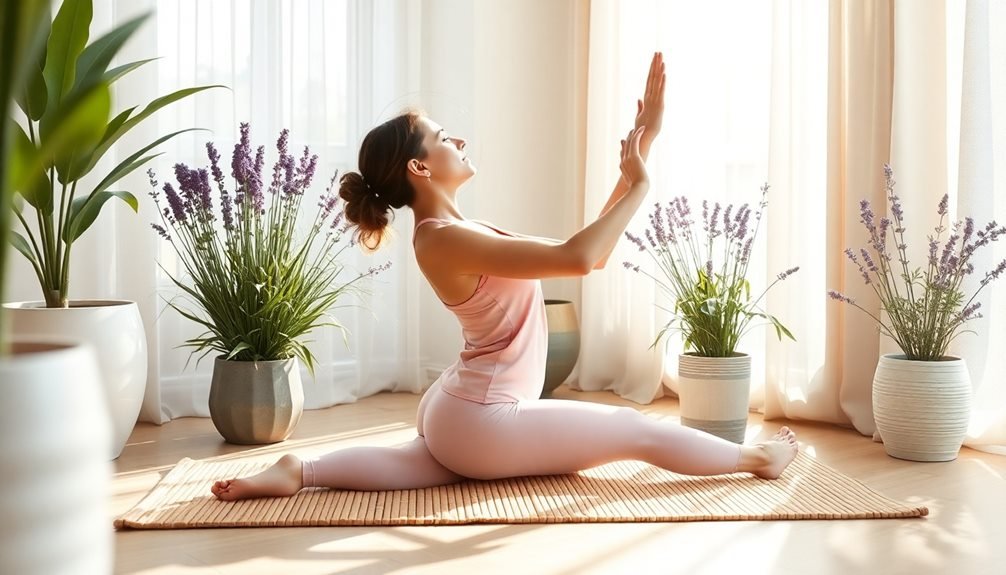
Leave a Reply